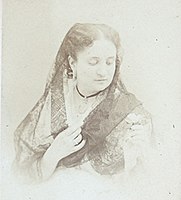
Photo from wikipedia
Abstract Made famous by Buñuel’s film version, Galdós’ Tristana remains one of the novelist’s most controversial works. Critics disagree over whether the two central characters are positively or negatively portrayed,… Click to show full abstract
Abstract Made famous by Buñuel’s film version, Galdós’ Tristana remains one of the novelist’s most controversial works. Critics disagree over whether the two central characters are positively or negatively portrayed, and whether the work is inspired by feminist sympathies or is, on the contrary, an ironic critique of feminist aspirations. We seem unable to locate the message of the novel with any degree of clarity. This article looks succinctly at key aspects of character-portrayal and at the use of an unstable narrator to argue that Galdós has pre-empted any one-sided conclusions, whether psychological or sociological, about the central issues raised by the novel.
Journal Title: Bulletin of Spanish Studies
Year Published: 2019
Link to full text (if available)
Share on Social Media: Sign Up to like & get
recommendations!